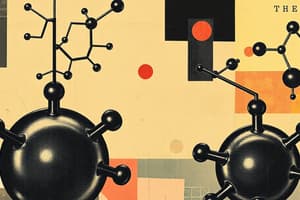Podcast
Questions and Answers
What type of bond is characterized by the transfer of one or more electrons?
What type of bond is characterized by the transfer of one or more electrons?
- Molecular orbital bond
- Hydrogen bond
- Covalent bond
- Ionic bond (correct)
Which bonding theory predicts the shape of molecules based on the arrangement of electron pairs?
Which bonding theory predicts the shape of molecules based on the arrangement of electron pairs?
- Bond Length Theory
- Molecular Orbital (MO) Theory
- Valence Shell Electron Pair Repulsion (VSEPR) Theory (correct)
- Electronegativity Theory
What is the distance between the nuclei of two bonded atoms?
What is the distance between the nuclei of two bonded atoms?
- Bond length (correct)
- Bond strength
- Bond polarity
- Electronegativity
Which type of bond is formed between a hydrogen atom bonded to a highly electronegative atom and another electronegative atom?
Which type of bond is formed between a hydrogen atom bonded to a highly electronegative atom and another electronegative atom?
What is the energy required to break a bond?
What is the energy required to break a bond?
Which bonding theory combines atomic orbitals to form molecular orbitals?
Which bonding theory combines atomic orbitals to form molecular orbitals?
What is the distribution of electrons within a bond?
What is the distribution of electrons within a bond?
Which type of bond is characterized by the sharing of electrons between atoms?
Which type of bond is characterized by the sharing of electrons between atoms?
Flashcards are hidden until you start studying
Study Notes
Types of Chemical Bonds
- Ionic Bond: A bond formed between two atoms that have a large difference in electronegativity, resulting in the transfer of one or more electrons.
- Characterized by the electrostatic attraction between oppositely charged ions.
- Typically formed between metals and nonmetals.
- Covalent Bond: A bond formed between two atoms that share one or more pairs of electrons.
- Characterized by the sharing of electrons between atoms.
- Can be polar or nonpolar, depending on the difference in electronegativity between atoms.
- Hydrogen Bond: A weak bond formed between a hydrogen atom bonded to a highly electronegative atom (such as oxygen, nitrogen, or fluorine) and another electronegative atom.
- Characterized by the electrostatic attraction between the hydrogen atom and the electronegative atom.
- Important in the structure and function of biological molecules.
Bonding Theories
- Valence Shell Electron Pair Repulsion (VSEPR) Theory: A model that predicts the shape of molecules based on the arrangement of electron pairs around the central atom.
- Electrons are arranged in a way that minimizes repulsion between them.
- Predicts the shape of molecules, including bond angles and polarity.
- Molecular Orbital (MO) Theory: A model that describes the distribution of electrons in a molecule.
- Combines atomic orbitals to form molecular orbitals.
- Predicts the energy and bonding properties of molecules.
Bond Characteristics
- Bond Length: The distance between the nuclei of two bonded atoms.
- Depends on the atoms involved and the type of bond.
- Bond Strength: The energy required to break a bond.
- Depends on the atoms involved and the type of bond.
- Bond Polarity: The distribution of electrons within a bond.
- Depends on the difference in electronegativity between atoms.
- Can result in a polar or nonpolar bond.
Intermolecular Forces
- Van der Waals Forces: Weak forces between molecules that arise from the interaction of electron clouds.
- Include London dispersion forces and dipole-dipole forces.
- Important in determining the physical properties of molecules.
- Dipole-Dipole Forces: Forces between molecules with permanent dipoles.
- Result from the electrostatic attraction between dipoles.
- Important in determining the physical properties of molecules.
- Hydrogen Bonding: A type of intermolecular force that arises from the interaction between hydrogen atoms bonded to electronegative atoms.
- Important in determining the physical properties of molecules, particularly in biological systems.
Types of Chemical Bonds
- Ionic bonds are formed between two atoms with a large electronegativity difference, resulting in electron transfer and electrostatic attraction between oppositely charged ions.
- Covalent bonds are formed between two atoms sharing one or more pairs of electrons, and can be polar or nonpolar depending on the electronegativity difference.
- Hydrogen bonds are weak bonds formed between a hydrogen atom bonded to a highly electronegative atom and another electronegative atom, characterized by electrostatic attraction.
Bonding Theories
- VSEPR theory predicts molecular shape based on electron pair arrangement, minimizing repulsion between electrons, and predicts bond angles and polarity.
- MO theory describes electron distribution in molecules, combining atomic orbitals to form molecular orbitals, and predicts energy and bonding properties.
Bond Characteristics
- Bond length refers to the distance between the nuclei of two bonded atoms, dependent on the atoms involved and bond type.
- Bond strength is the energy required to break a bond, dependent on the atoms involved and bond type.
- Bond polarity is the distribution of electrons within a bond, dependent on the electronegativity difference between atoms, resulting in polar or nonpolar bonds.
Intermolecular Forces
- Van der Waals forces are weak forces between molecules arising from electron cloud interaction, including London dispersion forces and dipole-dipole forces.
- Dipole-dipole forces are electrostatic attractions between permanent dipoles, important in determining physical properties.
- Hydrogen bonding is a type of intermolecular force arising from the interaction between hydrogen atoms bonded to electronegative atoms, important in biological systems.
Studying That Suits You
Use AI to generate personalized quizzes and flashcards to suit your learning preferences.




